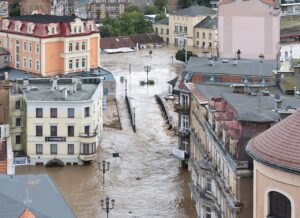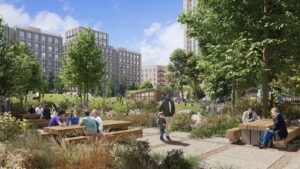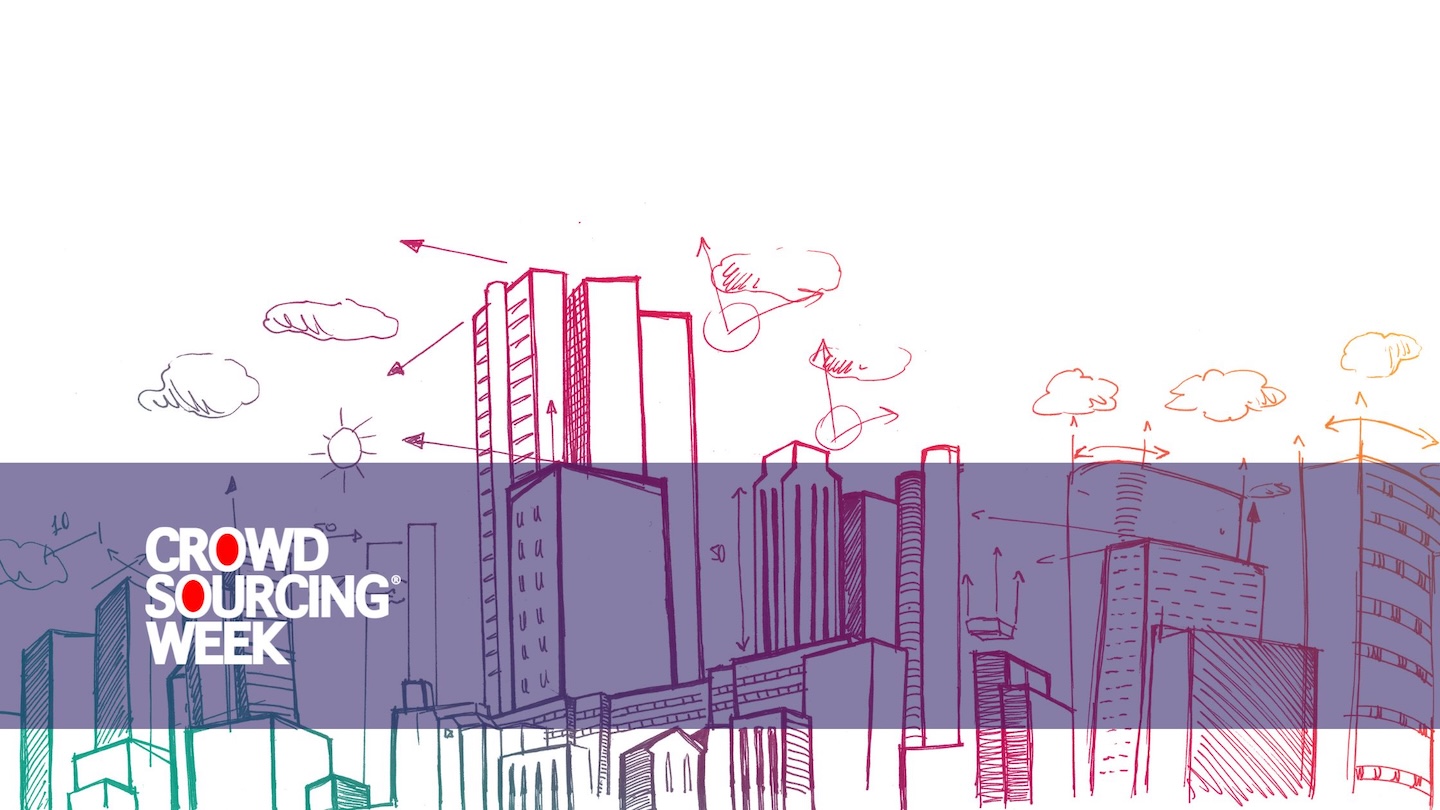Crowdsourcing is being used more frequently in many business, industrial, governmental and social sectors to allow people to contribute opinions, knowledge and expertise. Crowdsourced urban planning and design is no exception. There are growing challenges to overcome in this industry due to the continual population shift from rural to urban areas, more intensive weather extremes, greenhouse gas reduction aims, and more focus on personal wellness and safety. This blog will look at crowdsourced efforts and initiatives around the world, and covers various forms of crowdsourcing including open innovation challenges and prizes, crowdsourced data, and community crowdfunding.
The integration of crowdsourced urban planning data has become an integral part of contemporary built environment studies and design. The rapid growth in digital technologies and high levels of personal ownership of digital devices has made it possible to conduct research at scale and speed from many contributors. Also, automated data collection and management makes valuable information easier to employ. Coupled with social media that encourages everyone to voice their opinions, the use of crowdsourced data has shifted the dynamics of urban planning away from “the experts” to a more democratic situation that can include anyone who will live or work in a particular location. These participatory approaches now characterize modern urbanism.
There’s more to consider than climate change

Floods in Kłodzko, Poland, September 2024. Image source: Jacek Halicki
Extreme weather is intensifying, grabbing the media headlines and pushing the limits of traditional building design, construction regulations, and urban planning rules. Communities worldwide are recognizing that standard approaches are no longer sufficient to address rising challenges that include extreme heat, high winds, severe cold, and flooding.
In response, numerous initiatives and programs are emerging that prioritize community input to shape new rules, regulations, and planning standards for urban development. These efforts aim to enhance ongoing resilience, promote equity, and ensure that local knowledge informs solutions tailored to specific environmental and social contexts. They also aim to protect lives when weather conditions overwhelm historic precedence.
However, dealing with extreme weather is not the only factor influencing urban design and planning. Reducing carbon emission levels that have created the climate crisis, by measures including restricted use of vehicles, has obvious macro-benefits. Though at the same time they can cause a myriad of daily micro-problems for individual city residents and businesses. Coupled with the growth of online shopping, home deliveries of all these goods – plus on-demand ready-to-eat meals – put further pressures on urban landscapes and traffic management. Smart city infrastructure is providing better transport management and use of water and energy utilities.
There are also globally shared aims to make urban spaces, and the buildings within them, safer for our physical and mental wellbeing. Urbanization and modern day lifestyles have caused the majority of Americans to spend 87% of their day indoors. This has serious implications on improving the design of those indoor spaces. The amount of natural light, and views of natural scenes, have taken on greater importance to reduce stress and maintain mental resilience. In the UK, Covid lockdowns created a desire to move further from city centres in order to trade apartments for more spacious houses with access to a garden. This has continued to disrupt the UK real estate market since lockdowns ended.
Physical safety in urban environments is improved by better lighting, longer sightlines, fewer spaces for assailants to hide out of sight, and availability of data on crime levels to assess the relative safety of different locations and neighbourhoods.
Examples of crowdsourced urban planning in major cities
Here are some examples from major cities around the world.
North America
USA
One prominent approach is participatory planning, in which community members directly influence urban development policies. As an example, the U.S. Environmental Protection Agency (EPA) supports climate adaptation planning that encourages communities to assess their vulnerabilities to climate hazards and propose actionable solutions. The agency’s mission is to protect human health and the environment. Its processes often involve workshops, public forums, surveys, and input from citizen scientists to gather input on priorities such as green infrastructure—think rain gardens or permeable pavements—to mitigate flooding or urban heat islands.
The EPA also uses open innovation challenges and prizes to find crowdsourced urban planning solutions by tapping into the ingenuity and creativity of crowds.
New York City’s Climate Resiliency Design Guidelines stem from Local Law 41 of 2021, which mandates that infrastructure projects withstand future climate extremes. While driven by city leadership, the selection of pilot projects—40 initial sites ranging in budget from $3 million up to $1 billion —considered community exposure and equity, informed by public advocacy from environmental justice groups. This ensured that new standards for roads, sewers, and public housing reflected the needs of those most affected by flooding or heat.
Prior to this, Denver’s Denveright initiative, launched in 2018 and completed in 2021, was a three-year outreach and planning effort that crowdsourced input for four citywide plans: land use, transportation, parks, and pedestrian infrastructure. Using the Denver Moves online tool and pop-up events, over 15,000 residents provided feedback, proposing ideas like flood-absorbing greenways along the South Platte River and heat-resistant urban trails. The resulting blueprints, such as Blueprint Denver, incorporated these crowdsourced urban planning suggestions into zoning changes and public space designs, enhancing the city’s resilience to flooding and extreme heat while reflecting community priorities for equitable growth.
Starting in 2022, Phoenix, in Arizona, the HeatReady city initiative, leverages crowdsourced data from residents to combat extreme heat. Through a partnership with community apps and sensors (e.g., Netatmo weather stations), citizens provided real-time temperature and comfort feedback. This data informed urban design decisions, such as planting 1,000 additional trees by 2024 in heat-vulnerable neighbourhoods and installing misting stations, aligning with the city’s goal to enhance resilience against rising temperatures.
Miami’s Miami Forever Carbon Neutral plan, initiated in 2020, aims to achieve carbon neutrality by 2050 and uses crowdsourcing to refine its urban strategies. The city rolled out the Climate Ready Miami platform, inviting residents to suggest solutions for sea-level rise, heat, and flooding. By 2022, thousands of inputs—such as calls for elevated buildings in flood-prone Overtown and more shaded bus stops—shaped the plan’s focus on resilient infrastructure. These contributions have influenced Miami-Dade County’s building codes and urban design guidelines, prioritizing community-driven adaptations to climate threats.
Digital twin technology is a crucial tool in developing safer and more climate-resilient cities of the future, with Miami leading the way. It enables the online simulation of climate and disaster scenarios, optimization of evacuation and other safety plans, and tests regional resilience improvements. Changes can be made to urban design plans before work begins, accelerating the design process and avoiding expensive alterations when construction is underway.
Canada
Canada’s Climate-Resilient Buildings and Core Public Infrastructure Initiative exemplifies a national effort to integrate community perspectives. With $43.5 million in funding across a five year span from 2016 to 2021, it collaborated with local stakeholders to develop guides and standards for buildings and infrastructure.
Contributors to the initiative included engineering consulting firms, industry, academia, non-profit organizations, and the climate science community. Research into nature-based solutions in particular—like green roofs to combat urban heat or coastal wetland restoration to reduce flooding—benefitted from input from previously non- or under-represented northern and remote communities, ensuring that permafrost thaw or extreme wind considerations are addressed in updated building codes.
Europe
Extreme weather has devastated swathes of Europe in recent years. In 2024 alone, an enduring heatwave in Italy in July caused the government to issue excessive heat warnings in thirteen cities, and two firefighters were killed while fighting a wildfire.
 The Spanish coastal city of Valencia was inundated by torrential rain and catastrophic floodwater in October, in which over 220 people lost their lives. The cost of repairing or reconstructing damaged buildings is estimated at €1.7 billion.
The Spanish coastal city of Valencia was inundated by torrential rain and catastrophic floodwater in October, in which over 220 people lost their lives. The cost of repairing or reconstructing damaged buildings is estimated at €1.7 billion.
Also in June 2024, significant flooding struck southern Germany and caused the deaths of six people, plus the failure of several dams in the region. This required the evacuation of several municipalities and rescue missions.
The European Urban Initiative (EUI) fosters sustainable urban development by involving residents in designing scalable solutions. Under Poland’s presidency in 2025, the EU has made urban development and the transition to more sustainable cities one of its key thematic priorities. Through its Portico platform, urban policymakers and citizens collaborate to share knowledge and develop strategies, such as flood-resistant infrastructure or heatwave-ready public spaces. This initiative emphasizes participatory processes to ensure that new zoning or building standards reflect community needs, especially in vulnerable areas prone to extreme weather.
Crowdsourced urban planning and designing cities with community input have gained traction as countries adapt to extreme weather and other urban challenges. Below are specific examples where residents of major European cities have actively shaped urban development, focusing on resilience, sustainability, and local needs. These initiatives showcase how community voices are integrated into new rules, regulations, and planning standards to address issues like heat, flooding, and wind strength.
Spain
The Spanish Urban Agenda, launched in 2019, encourages over 120 cities and towns—like Madrid, Barcelona, and Málaga—to develop Local Action Plans with community input. In Málaga, residents participated in forums to address extreme heat and flooding, proposing urban forests and rainwater harvesting systems. These ideas have shaped municipal regulations, mandating green roofs and flood-resistant building designs. The SUA’s participatory “à la carte” framework lets communities tailor solutions, making urban planning responsive to local climate challenges.
Barcelona
Barcelona’s superblock initiative reimagines urban spaces by reducing car dominance and enhancing walkability, with significant community involvement. Residents in neighbourhoods like Poblenou co-designed car-free zones, advocating for shaded public squares and flood-absorbing green spaces to combat heatwaves and heavy rainfall. Their input has refined city planning standards, integrating climate-adaptive features like elevated walkways and water-retention basins, now mandatory in new developments.
Pamplona
The EU’s URBAN Community Initiative in Pamplona during the 1990s and early 2000s involved residents in regenerating the historic Rochapea district. Through participatory workshops, locals identified flood risks from the Arga River and pushed for raised housing and improved drainage. These efforts influenced Spain’s adoption of collaborative planning models, with Pamplona’s updated codes now requiring community input for flood-resilient urban designs—a legacy still guiding modern projects.
Germany
Hamburg
Hamburg is one of Germany’s three city states and is located on its North Sea coastline. It is thus a major port and trading centre, and also a relatively early adopter of crowdsourced urban planning.
In 2016, Hamburg’s FindingPlaces initiative used MIT’s CityScope platform to involve citizens in selecting sites for refugee housing. Residents mapped flood- and heat-vulnerable areas, advocating for locations with natural cooling and drainage features. Their input not only balanced housing distribution but also influenced Hamburg’s climate-adaptive zoning laws, mandating community consultation for projects in high-risk zones. This model has set a precedent for participatory resilience planning.
NextHamburg is a citizen-led think tank that crowdsources ideas to shape Hamburg’s future. Residents submit proposals online—such as expanding the city’s Green Network, which aims to make 40% of Hamburg car-free and climate-resilient by 2035. Community suggestions for wind-resistant tree planting and floodable parks have been adopted into Hamburg’s urban planning policies, ensuring new developments prioritize natural buffers against extreme weather. This bottom-up approach has inspired similar efforts across Germany.
Berlin
Berlin leverages community input to rethink tourism-driven urban changes, as seen in projects like the Humboldt Forum redevelopment. Residents in surrounding districts pushed for heat-mitigating green roofs and flood-resistant public spaces, reflecting local experiences with summer heatwaves and the Spree River flooding. These contributions have updated Berlin’s building codes to prioritize climate-smart designs, with ongoing citizen forums ensuring new standards evolve with community needs.
United Kingdom
Here are some UK initiatives that brought crowdsourcing in to use for urban design and planning.
Civic crowdfunding
Spacehive is a UK-based platform that empowers communities to crowdfund civic projects, effectively crowdsourcing urban improvements. Several local government councils throughout the UK work with Spacehive to use civic crowdfunding as a means to identify which local projects each community is most willing to support through raising money towards the cost.
In London, residents funded the Peckham Coal Line. A disused elevated railway track in a London inner city borough, formerly an industrial area, was transformed to a public park. No doubt it was inspired by New York’s High Line and the Promenade Plantée in Paris. Community input shaped the Peckham Coal Line design to include flood-mitigating greenery and heat-reducing tree cover, aligning with new urban standards for climate resilience. Civic crowdfunding raised the initial £10,000 required for a feasibility study, and the project was also supported by funding made available by the Mayor of London.
In Manchester, locals backed a project to convert vacant lots into community gardens, influencing local councils to revise zoning rules to support such adaptive, resident-led initiatives. The crowdfunding project raised over £200,000 through the sale of community shares, rather than simply asking for donations. Issuing community shares puts local community projects on a more accountable and business-like basis.
Spacehive is also able to provide match-funding provided by private businesses and foundations.
Crowdsourcing input for inner city regeneration
Bristol Rising is a standout example of community-driven urban revitalization. Launched by officials in the city of Bristol, this initiative invited residents to propose ideas for transforming Bristol’s struggling downtown into a vibrant, walkable hub. Through an interactive online platform, citizens uploaded suggestions—ranging from new green spaces to pedestrian zones—and engaged in discussions. The process directly influenced development priorities, ensuring they reflected local desires for sustainability and resilience against flooding, a recurring issue in Bristol due to its proximity to the River Avon. This input has guided updated planning frameworks to prioritize flood-resistant infrastructure and public spaces that cool the urban heat island effect.

Image source: The Canada Water Masterplan
Canada Water is an inner city redevelopment in south London, currently transforming a previously rundown industrial and dockside environment covering 52 acres. A partnership between the landowner, the main investor, and the local borough council has worked hard with the local community to create an outstanding new town centre within the borough of Southwark, and make a positive long-term contribution to local life.
Through public consultation, more than 5,000 people have contributed to directly informing the plans and establishing key areas of commitment to create a mixed work, retail and residential space that embraces wellness and nature, and is ready to contribute to climate sustainability.
Crime prevention and personal safety
A recent pilot study for a project that aims to improve personal safety in an urban environment assessed various datasets, including those provided by London transport systems, the police, open sources, crowdsourced, and social media, using machine learning algorithms, to uncover potential patterns and ascertain the data’s predictive capacity regarding future crime activities.
The purpose is to develop an app that will deliver tailored safety messages to diverse user personas. When a pedestrian inquires about a location’s safety, the system will retrieve recent crime statistics, station records, and more, as base features, and then use the previously provided user persona to give appropriate advice to predict the safety of that street. What might be considered safe for a young white male may not be safe for a young woman, a person of particular ethnic origin or religion, an elderly person, and so on.
Local authorities will be able to access the data findings to identify where personal safety improvements are required, thus using crowdsourced urban planning.
India
The Safetipin app is designed to allow users to provide crowdsourced data on urban environments to improve levels of personal safety. It enables people to input details of elements such as street lighting, the presence of CCTV, and pavement quality, on to a map, along with a perceived safety score. Safetipin then offers safer routes and notifies users of the nearest safe spot in an unsafe area.
The data is also provided to urban planners and other government offices to see where they should consider improving the quality of street lighting and pavement, and install safety measures such as CCTV. In New Delhi, use of Safetipin’s crowdsourced data led to reducing the number of dark spots in the city by more than 60% from 7,438 in 2016 to 2,780 in 2018. The police also reorganized their patrol routes.
Safetipin now operates beyond India in 77 cities across 16 countries. The rise in numbers of gig-workers, often making deliveries in urban areas, has left a growing group of female workers at a disadvantage. Recent research among female gig workers in the transport and logistics sector across South Asia, including India, Pakistan, Nepal, Sri Lanka, and Bangladesh, revealed the degree to which they often face additional layers of discrimination and safety risks. Providing data makes it harder for authorities to brush away concerns and the need for action.
A Common Thread
A common thread across these crowdsourced urban planning initiatives is the use of tools like the Climate-Resilient Development Index, piloted by the Urban Institute. This index helps local leaders evaluate zoning codes against climate risks, incorporating community data to prioritize housing development in less hazard-prone areas. Posts on X have highlighted how such tools empower residents to push for rules that balance resilience with affordability, reflecting a growing public demand for inclusive planning.
These programs often blend top-down expertise with bottom-up input. For example, the United Nations’ Urban Climate Change Research Network encourages cities to adopt risk-informed land-use planning with community engagement, as seen in Chișinău, Moldova, where residents helped map seismic and flood risks. Similarly, Water Sensitive Urban Design (WSUD) in Europe, mandated by directives like the EU Floods Directive, involves local stakeholders in crafting water management plans that address flooding while enhancing ecosystems—think of urban playgrounds designed to double as rainwater basins.
Challenges remain
Limited municipal capacity, especially in under-resourced areas, can hinder effective participation, as noted in global reports on urban risk. Data gaps—like sub-daily rainfall projections—also complicate planning for extreme events. Yet, the shift toward community-driven standards is clear: it’s about empowering people to co-create safer, healthier cities that can withstand the worsening storms, heatwaves, and floods of tomorrow. These initiatives show that when residents have a voice, the resulting rules and designs are not just more resilient but also more equitable and practical.
Let’s continue a conversation. Please let us know about your own experiences of contributing to, or of using crowdsourced data for use in urban planning of some description.




0 Comments